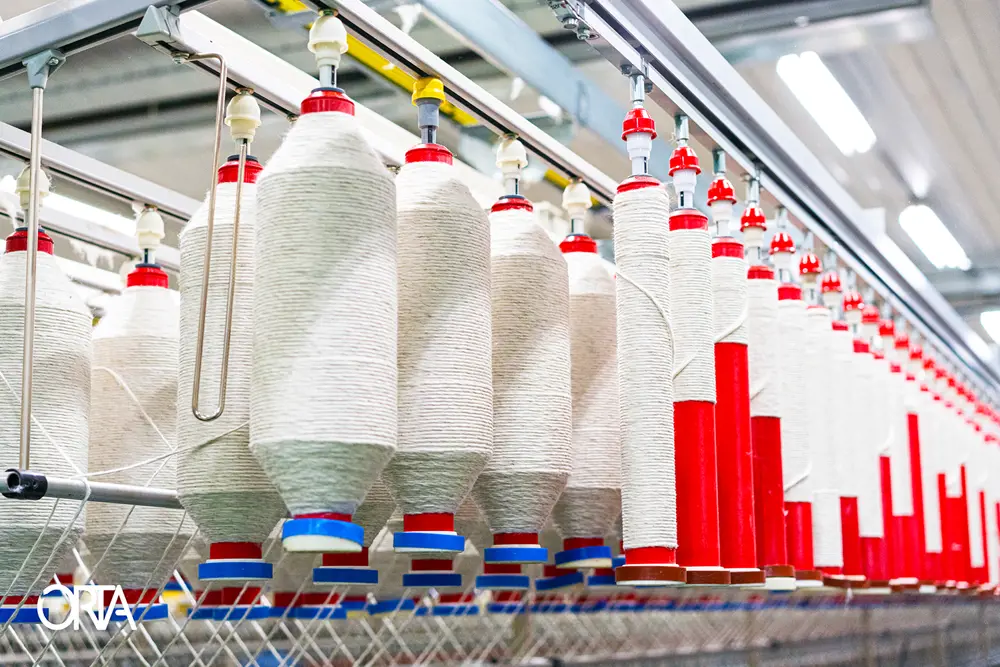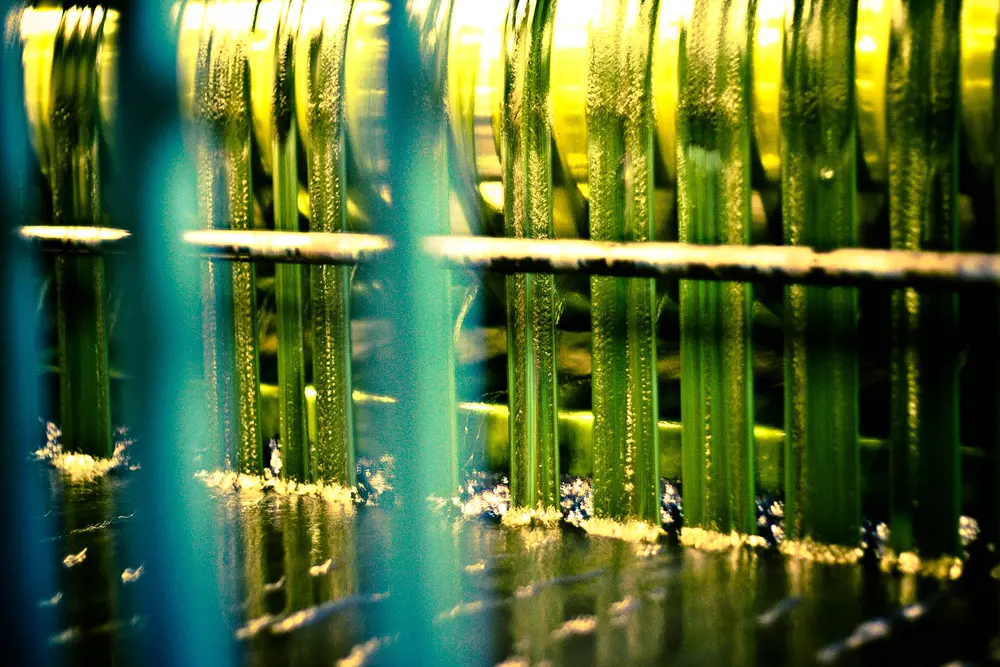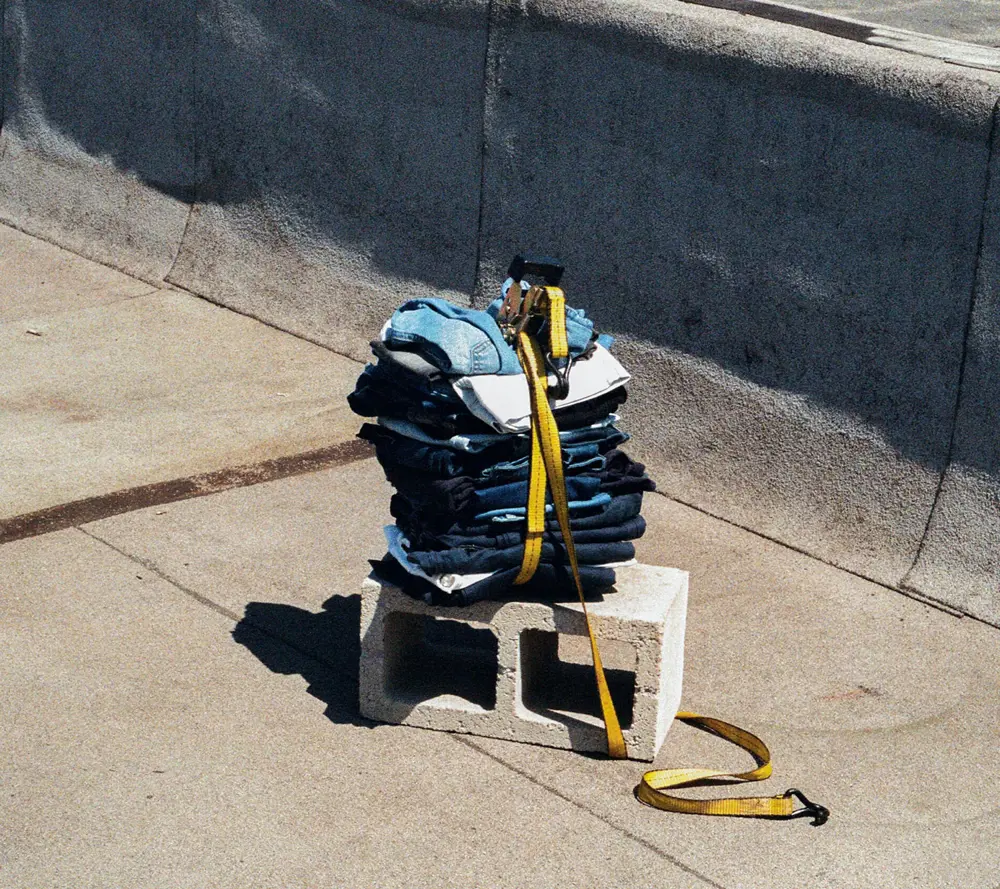
Turning jeans green
Did you know?
Discover more about denim.
- Denim’s characteristic appearance comes from weaving together indigo ‘warp’ (up-and-down) threads into undyed ‘weft’ (left-and-right) threads. The warp yarns are predominant on the face, which is why the outside is bluer and the inside is paler coloured
- Most denim is made on an automated loom where projectiles carrying the threads are fired back and forth
- Instead of chemically synthesised indigo, synthetic biologists have developed an approach to dye fabrics using bacteria fermented in large tanks, like those used for brewing beer
It’s been 150 years since Levi Strauss filed a patent for riveted work trousers, the robust workwear worn by California’s gold rush miners that would become the blue jeans we know and love today. Back then, jeans were made to last, and they were much simpler to make.
Fast forward to the 21st century, and our jeans have become a go-to garment for virtually any occasion. The array of colours, textures and embellishments we now expect from denims has made them more complex to make, harder to recycle, and they don’t last as long, condemning them to landfill sooner.
Jeans are also an incredibly resource-hungry product, for several reasons. Firstly, they’re made of cotton, a notoriously thirsty crop that is often grown in water-stressed areas with harmful pesticides. Secondly, there’s the distinctive indigo hue and worn-in look we expect from denim. This is achieved by a series of dyeing and finishing methods that use dangerous chemicals – sometimes including carcinogenic azo dyes and heavy metals – and vast quantities of water.
This all takes a significant toll on people and the planet. What measures are being taken to make this wardrobe staple more sustainable?

Cotton: the key ingredient
Cotton is the standard fibre for making denim, although other plant-based fibres, including viscose, lyocell, modal, and hemp (known collectively as cellulosic fibres) can also be used. About 25 million tonnes of cotton are grown each year, with China, the US and India being the top producers worldwide.
Depending on where it’s cultivated, it takes thousands of litres of water to produce a kilogram of cotton. In Uzbekistan, cotton farming has consumed so much water that the Aral Sea, once one of the world’s four largest lakes, has almost dried up.
Most cotton is grown with fertilisers and pesticides, which can pollute local water supplies. Pesticides can be particularly hazardous to human health. In 2022, a report compiled by environmental groups estimated that each year, 385 million people globally experience unintentional poisoning by pesticides, resulting in 11,000 deaths.
To reduce these impacts of cotton production, many jeans manufacturers are turning to organic and recycled cotton. Unfortunately, because of limited availability, neither material is a panacea. Instead, some brands are using deadstock (leftover) fabrics, or turning to fast-growing hemp and nettle fibres – usually at high-end prices.
In Uzbekistan, cotton farming has consumed so much water that the Aral Sea, once one of the world’s four largest lakes, has almost dried up.
How to make a pair of jeans
Once the textile fibres are in hand, there are many steps that go into making a pair of jeans, including spinning, dyeing, weaving, washing, and finishing.
Spinning
After the cotton is cleaned and combed, its fibres are spun into yarns. Spinning consumes a lot of electricity – to run the machines, as well as maintain the optimal temperature and humidity. Ventilation systems and local suction systems at each machine keep the air clean, as errant cotton fibres settling in the wrong places, along with dust, can create impurities in the fabric.
Dyeing
The yarns are then dyed either individually, as a sheet (known as slasher dyeing) or bundled into ropes (rope dyeing). Successive dips into a series of dye baths, or boxes, deepens the colour to the right shade of indigo. The yarns might be dyed again after they have been woven into a textile, and once again after the fabric has been made into a garment.

More environmentally friendly dyes
What options are out there to dye textiles without harming the planet?
Sulfur dyes
Sulfur dyes are widely used as a less water-intensive alternative to indigo. These dyes have a better affinity for cotton, requiring fewer dye baths and offering improved colour fastness (resistance to fading or transfer). One such dye is the Advanced Denim system developed by Archroma. It uses a single dyeing box and another box containing a sugar-based reducing agent to achieve a medium colour intensity, greatly saving on water and energy consumption. The company claims that no wastewater is produced at all.
Bacteria-based dyes
To avoid the toxic chemicals associated with dyes altogether, some companies, including Norwich-based Colorifix and California-based Tinctorium, are genetically modifying microorganisms to recreate pigments found in nature, such as indigo.
- Tinctorium grows genetically modified bacteria that produce a precursor to indigo. It uses an enzyme – instead of a chemical agent – to reduce the pigment to leucoindigo. As indigo produced in this way has the same chemical structure as naturally occurring and synthetic indigo, it can be used in conventional dyeing machines.
- Colorifix, meanwhile, has developed an entire array of bacteria-based dyes. It first uses digital gene databases to identify the DNA linked to pigments found in nature, whether from a plant, animal, insect, or microbe. Then, it programs this code into microbes so that they produce the pigment. The microbes (and as a result, the pigment) can then be grown in fermentation tanks – similar to brewing beer. The company says its dyeing process reduces water consumption by 49% compared with conventional approaches, and requires no extra dyeing chemicals, as the cells themselves are used to deposit the pigment into fibres. According to an interview with CEO, Dr Orr Yarkoni in SynBioBeta, the company has even piloted fermentation and dyeing using saltwater, to save stretched freshwater resources.
Foam dyeing
Foam dyeing is another alternative method of dyeing that requires less water. Colour is transferred through a foam, so there is no need for successive dye baths. Jeans brand Wrangler uses a foam dyeing process developed by Texas Tech University in its IndigoodTM range.
Indigo is the traditional dye used in denim manufacture, although the majority of denim makers use synthetic indigo. As indigo is not water-soluble, it must be chemically altered (reduced) before it can bond to the cellulose fibres. This is often done by adding the bleach sodium hydrosulphite. However, scientists have developed other cleaner, less water-intensive methods for doing the job, including electrochemical reduction.
Reduced indigo, called leucoindigo, is pale yellow. After their dye bath, the yarns are oxidised – exposed to air – again, so that the indigo can return to its insoluble form and its blue colour.
Dyeing is a part of the manufacturing process that often does the most environmental harm. It uses vast quantities of water, as denim yarns are cleaned, dipped in up to 13 dye baths (thousands of litres each), and then rinsed. And the resulting wastewater – contaminated by the chemicals that fix the dye to the fabric, unbonded residual dye and cotton fibres – has to go somewhere. It many cases, it is dumped into local waterways, turning rivers black and making local people sick, from Savar in Bangladesh to Kathmandu.
It many cases, dye wastewater is dumped into local waterways, turning rivers black and making local people sick, from Savar in Bangladesh to Kathmandu.
However, Dr Mark Sumner, a lecturer in sustainable fashion at the University of Leeds School of Design, says that many responsible retailers and brands are working with suppliers that have effective effluent treatment plants, where the chemicals and solids are extracted from the effluent before it is discharged. He notes, however, that “treatment plants use lots of water and energy. There’s a financial and environmental cost associated with that.”
Nevertheless, there are several innovative approaches that have been developed to reduce the impact of dyeing denim (see ‘More environmentally friendly dyes’).

Weaving
Denim is made on industrial looms, where the white (or ecru, meaning undyed) weft (left-to-right) yarns are woven into the indigo warp (up-and-down) yarns. When the fabric is ready, it goes to the garment manufacturers, who cut it, sew it, and add accessories such as buttons and rivets.
Washing and finishing
In the next step, the jeans are washed and finished to create a ‘worn-in’ style. This transforms them from a dark, stiff pair of trousers into pieces with mass-market appeal, with what looks like a bit of a history.
For instance, to fade the indigo, jeans are often stonewashed, in a laundry machine with pumice stones. This also softens the fabric, so they’re more comfortable to wear. However, like so many other stages of denim production, stonewashing consumes a lot of water and produces effluent contaminated with residual dye.
There is another undesired effect: “As well as removing the colour that’s been put in through these long dyeing processes, you’re also reducing the lifetime of the product,” Sumner says.
Eco-conscious denim makers are turning to less water-intensive methods of bleaching that do not damage the garment. These include enzyme washing, where cellulase enzymes break down the dyes and soften the denim; and ozone washing, where ozone is added to the wash to fade the fabric without producing the polluting effluent.
Finishing also covers the final touches jeans go through before hitting the rails. Well-worn jeans bear a set of characteristic markings that suggest a life well lived, including the ‘whiskers’ near the front pockets. These markings are often made using potassium permanganate, a strong oxidising agent that can burn the skin and damage the eyes. Lasering offers a water- and chemical-free method of creating these features, and according to online denim guide Denimhunters, gives more consistent results than potassium permanganate.
Making fashion circular
Evidently, a lot of work is under way to make jeans manufacturing less of an environmental burden.
But reducing a garment’s environmental impact requires consideration of its entire lifecycle – not just production. This is the thinking behind a circular economy, where resource management and production methods are transformed to eliminate pollution and waste. With this in mind, the Ellen MacArthur Foundation has created a set of recommendations to help manufacturers and brands reduce the waste and pollution associated with making jeans, and make garments easier to recycle.
The foundation’s Jeans Redesign bases its guidelines on three focus areas, which are that “jeans are designed to be used more, made to be made again, and made from safe and recycled or renewable inputs”.
Testing garments for durability is a key recommendation, with one minimum requirement being that jeans should survive at least 30 washes. ‘Emotional’ durability is also an important factor – that is, that garments remain “relevant and desirable” to the wearer.
One of the minimum requirements of recyclability is that garments are made of at least 98% cellulose-based fibres in the total textile composition, while another is that any components in the garment, such as fastenings, are easy to remove.
Sebla Önder, sustainability specialist for the Turkey-based denim manufacturer Orta Anadolu, says that from a sustainability point of view, when creating denim from scratch, it is best to keep things simple.
She recommends making jeans from 100% cotton, which makes the garment easier to recycle, and sticking to a midshade indigo to reduce the amount of dye required (as fewer dips in the indigo baths are needed). She notes how energy consumption quickly snowballs when extra processes are added to denim production; for example, bringing 2% elastane into the textile composition requires not just the extra step of adding the elastane but also the step of heating the textile to fix it. Here, just one extra ingredient requires two extra processes.

How to spot greenwashing
What (really) makes a more sustainable choice?
Sustainability has become increasingly important to the average consumer, and more of us are taking practical steps to shop responsibly – brilliant news for everyone and the planet.
The not-so-brilliant news is that brands that cannot demonstrate their eco credentials will still market themselves as environmentally friendly, in a practice known as greenwashing.
As consumers, we must look past the labels saying ‘sustainable’, ‘recycled’, or ‘responsible’, and instead find out what the brands are actually doing. Many garments have a long supply chain and there’s no way of conveying all relevant information about how a piece was made on a label.
“If you want to be more sustainable in terms of your fashion choices, you have to do a bit of research,” says Sumner. He recommends checking brand websites for corporate statements about their position on sustainability. “If they are saying nothing about their sustainability agenda, or what they’re doing, we have to assume they’re doing nothing,” he says.
With all this in mind, how can you make better choices as a consumer? When in the market for any new garment, Sumner recommends thinking first about whether you actually like it, and then how often you think you’re going to wear it – not necessarily how long you think you’ll have it. “Keeping it in your wardrobe and not wearing it is probably the worst thing you can do with any garment,” he says.
He adds that we should also think about aftercare, taking steps to preserve the life of the piece such as by washing only when we really need to, and avoiding tumble drying.
As scientific and engineering innovations continue to transform a centuries-old industry, making it fitter for the future, it is worth remembering that our choices as consumers can still have an impact.
***
This article has been adapted from "Turning jeans green", which originally appeared in the print edition of Ingenia 95 (June 2023).
Contributors
Dr Mark Sumner has a diverse research portfolio that includes textile and fashion sustainability, microplastics, modern slavery, and consumer behaviour. Mark developed his textiles and sustainability expertise by working for the UK’s largest clothing retailer for over 15 years, where he was involved in supply chain management, textile innovations and sustainability. He has made major contributions to several UK and International sustainability initiatives including Sustainable Clothing Action Plan 2020, Textiles 2030 and ZDHC. Mark also contributed to the House of Commons Environmental Audit Committee report on fast fashion.
Sebla Önder has a background in the chemicals sector and sustainability consultancy, she has worked in multiple industries, from textiles to construction. Sebla is a chemical engineer who graduated from Yeditepe University in Istanbul, Turkey, and holds a master’s degree in sustainable energy engineering and policy from Carleton University in Ottawa, Canada.
Leonie Mercedes
Author
Keep up-to-date with Ingenia for free
SubscribeRelated content
Design & manufacturing

Super cool(er)
Welsh startup Sure Chill has developed a cooler that uses the properties of water to keep its contents cool for around 10 days without electricity. This is ideal for storing items such as vaccines where electricity sources are unreliable.

R&D investment makes good business sense
In just five years, Dr Ralf Speth FREng has presided over a revolution in design and manufacturing that has helped create a new family of engines and has overhauled Jaguar Land Rover (JLR) production facilities.

Steel can arise from the ashes of coal
Thousands of people were laid off in the UK steel industry in 2015 and there are pessimistic future forecasts. Professor Sridhar Seetharaman of the Warwick Manufacturing Group argues that smaller, flexible steel mills implementing new technology would better cope with fluctuating global trends.

Integrating metrology in business and academe
Professor Jane Jiang’s interest in measuring began when she worked on a bus production line in China. She found that the best way to improve quality, consistency and productivity was through metrology, the science of measurement. Today, she runs the UK’s largest metrology research group.
Other content from Ingenia
Quick read

- Environment & sustainability
- Opinion
A young engineer’s perspective on the good, the bad and the ugly of COP27

- Environment & sustainability
- Issue 95
How do we pay for net zero technologies?
Quick read

- Transport
- Mechanical
- How I got here
Electrifying trains and STEMAZING outreach

- Civil & structural
- Environment & sustainability
- Issue 95